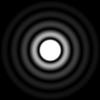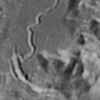
Testing for Visual Acuity - need user data
Started by
EdZ
, May 21 2003 08:36 PM
No replies to this topic
#1

Posted 21 May 2003 - 08:36 PM
I’m very interested in collecting results from any observers, binocular or telescope, that might lead to some realistic conclusions concerning acuity. Having determined acuity, we should be able to compare results of resolution tests from various individuals, as long as all other measurement criteria are held constant. The end results of this test data will eventually produce an article to be published here at CN. (another technical ed article!). The following describes what I’m looking for. Thanks in advance for your help. edz
Please Email results to me at my email
Visual Acuity is a limiting factor in the eye’s ability to achieve resolution and magnification is employed to make an image large enough for the eye to perceive. If your visual acuity is 200 arcseconds, you need 12x mag to see a 17” double or 20x mag to see a 10” double.
Acuity can be measured as the apparent separation results for a range of varying doubles recorded with one or more pieces of equipment. The results will fall into a fairly narrow range. This would be the observer's acuity range.
“The resolution of the eye is 3 to 5 minutes of arc; therefore a minimum magnification must be utilized to enlarge the image sufficiently to exceed the eye’s resolution.” C. R. Kitchin, “Telescopes and Techniques” Springer-Verlag, 1995. Other sources will quote lower limits. My personal records of many doubles puts me right in the middle of this range. Possibly some observers can achieve better results.
In my best binoculars I can rarely achieve apparent separations of less than 200 arc-seconds. I’ve recorded many observations between 210 and 240 arc-sec. Some telescope results are slightly better, possibly attributed to the better resolution of telescopes. The best results I’ve achieved with very good optics was about 160 arc-sec, equivalent to a 2” double at 80x. The closer the doubles or the wider the mag delta, the harder it becomes to achieve these results, and therefore the higher the end result acuity factor.
So my usual visual acuity is 3 to 4 arc minutes. I am not capable of seeing separation in a 4 arc-min pair naked eye; I cannot see e1-e2 Lyra (207") as separated. Optics improve the point source resolution and contrast making it easier to see separation than is possible by naked eye.
I've read one binocular observer was able to split doubles of 4 seconds magnified 20x = to apparent separation 80 arcsec!! My results do not indicate this cannot be accomplished, but they indicate it’s clear if we wish to compare our ability to perceive resolution with our instruments, we need to first establish the visual acuity of the individuals. Anyone ever split Castor 4” or Algeiba 4.4” with 20x or 25x binoculars?
We could test acuity with a list of doubles. Some that might get better success with binoculars are 17CrB at 6” or 7CrB at 6.3”, E(sigma)953 in Mon at 7.1”, Mesartim y Ari at 7.8” or y Del at 9.6”. A wide range of binocs might be able to see these close matched doubles. Of these I've only seen yDel split with binoculars. A great challenge is the Trapezium BD=19.2”, CD=13.3”, AC=12.9” and finally AB=8.7”. I have seen all four components split with 20x80s. Smaller binocs try 100Herc at 14.2” or any one of many doubles around 20”. With telescopes for each double you try, record the lowest magnification that splits it.
Some may achieve acuity of 2.5 arc minutes or 150”, or less, requiring a magnification of only 150”/9.6” or 16x to see separation in yDel.
75 Her is listed as 4.6-5.6/4.1" an easy telescope double, and as it turns out pretty good proof for me that I can’t see 4” doubles with any binoculars I own. I used various eyepieces in my TV85(85/600) and AT1010 (78/480) to test low limit. The results were the nearly identical in both scopes. Eyepieces used were 18UOor, 15TVpl, 14TVrad, 12.5UOor, 12UOkon, 11TVpl, 10TVrad.
At magnifications below 40x, I was not able to see anything more than a single star.
At 40x I was able to detect elongation and suspected a double.
At 43x and 44x I just barely split the two components.
At 48x I was able to confirm seeing two components clearly.
Magnifications of 43x and 44x result in apparent separation of 176 to 180 arc-seconds. The better view was at a magnification of 48x with an apparent separation of 197 arc-seconds. This agrees with the results I get for many of the other doubles that I've recorded, that I have a measurable acuity allowing me to see resolved components when I reach an apparent separation of 3 arcmin, in this case from approx 180 arcsec to 200 arcsec.
This does not indicate that you can or cannot see it at a much lower magnification of 20x with an apparent separation of 82 arc-seconds. What is does is makes it clear that if we collectively are to record data measuring the resolution of our instruments, especially binoculars, we must first establish the visual acuity of the individuals.
Measuring visual acuity is not the same as measuring the resolving ability of your instrument. Resolving is the closest components that can be detected. Acuity is the apparent separation results for a range of varying width doubles measured with various equipment, or even measured with one piece of equipment on various targets. It is surprising how the apparent separation results for a variety of doubles will fall into a fairly narrow range. This would be the observer's acuity range.
Again I’ll request that you send your results to me at my email.
OR post your best binocular results here to let others know what binoculars are capable of doing.
Thanks, edz
Please Email results to me at my email
Visual Acuity is a limiting factor in the eye’s ability to achieve resolution and magnification is employed to make an image large enough for the eye to perceive. If your visual acuity is 200 arcseconds, you need 12x mag to see a 17” double or 20x mag to see a 10” double.
Acuity can be measured as the apparent separation results for a range of varying doubles recorded with one or more pieces of equipment. The results will fall into a fairly narrow range. This would be the observer's acuity range.
“The resolution of the eye is 3 to 5 minutes of arc; therefore a minimum magnification must be utilized to enlarge the image sufficiently to exceed the eye’s resolution.” C. R. Kitchin, “Telescopes and Techniques” Springer-Verlag, 1995. Other sources will quote lower limits. My personal records of many doubles puts me right in the middle of this range. Possibly some observers can achieve better results.
In my best binoculars I can rarely achieve apparent separations of less than 200 arc-seconds. I’ve recorded many observations between 210 and 240 arc-sec. Some telescope results are slightly better, possibly attributed to the better resolution of telescopes. The best results I’ve achieved with very good optics was about 160 arc-sec, equivalent to a 2” double at 80x. The closer the doubles or the wider the mag delta, the harder it becomes to achieve these results, and therefore the higher the end result acuity factor.
So my usual visual acuity is 3 to 4 arc minutes. I am not capable of seeing separation in a 4 arc-min pair naked eye; I cannot see e1-e2 Lyra (207") as separated. Optics improve the point source resolution and contrast making it easier to see separation than is possible by naked eye.
I've read one binocular observer was able to split doubles of 4 seconds magnified 20x = to apparent separation 80 arcsec!! My results do not indicate this cannot be accomplished, but they indicate it’s clear if we wish to compare our ability to perceive resolution with our instruments, we need to first establish the visual acuity of the individuals. Anyone ever split Castor 4” or Algeiba 4.4” with 20x or 25x binoculars?
We could test acuity with a list of doubles. Some that might get better success with binoculars are 17CrB at 6” or 7CrB at 6.3”, E(sigma)953 in Mon at 7.1”, Mesartim y Ari at 7.8” or y Del at 9.6”. A wide range of binocs might be able to see these close matched doubles. Of these I've only seen yDel split with binoculars. A great challenge is the Trapezium BD=19.2”, CD=13.3”, AC=12.9” and finally AB=8.7”. I have seen all four components split with 20x80s. Smaller binocs try 100Herc at 14.2” or any one of many doubles around 20”. With telescopes for each double you try, record the lowest magnification that splits it.
Some may achieve acuity of 2.5 arc minutes or 150”, or less, requiring a magnification of only 150”/9.6” or 16x to see separation in yDel.
75 Her is listed as 4.6-5.6/4.1" an easy telescope double, and as it turns out pretty good proof for me that I can’t see 4” doubles with any binoculars I own. I used various eyepieces in my TV85(85/600) and AT1010 (78/480) to test low limit. The results were the nearly identical in both scopes. Eyepieces used were 18UOor, 15TVpl, 14TVrad, 12.5UOor, 12UOkon, 11TVpl, 10TVrad.
At magnifications below 40x, I was not able to see anything more than a single star.
At 40x I was able to detect elongation and suspected a double.
At 43x and 44x I just barely split the two components.
At 48x I was able to confirm seeing two components clearly.
Magnifications of 43x and 44x result in apparent separation of 176 to 180 arc-seconds. The better view was at a magnification of 48x with an apparent separation of 197 arc-seconds. This agrees with the results I get for many of the other doubles that I've recorded, that I have a measurable acuity allowing me to see resolved components when I reach an apparent separation of 3 arcmin, in this case from approx 180 arcsec to 200 arcsec.
This does not indicate that you can or cannot see it at a much lower magnification of 20x with an apparent separation of 82 arc-seconds. What is does is makes it clear that if we collectively are to record data measuring the resolution of our instruments, especially binoculars, we must first establish the visual acuity of the individuals.
Measuring visual acuity is not the same as measuring the resolving ability of your instrument. Resolving is the closest components that can be detected. Acuity is the apparent separation results for a range of varying width doubles measured with various equipment, or even measured with one piece of equipment on various targets. It is surprising how the apparent separation results for a variety of doubles will fall into a fairly narrow range. This would be the observer's acuity range.
Again I’ll request that you send your results to me at my email.
OR post your best binocular results here to let others know what binoculars are capable of doing.
Thanks, edz

















